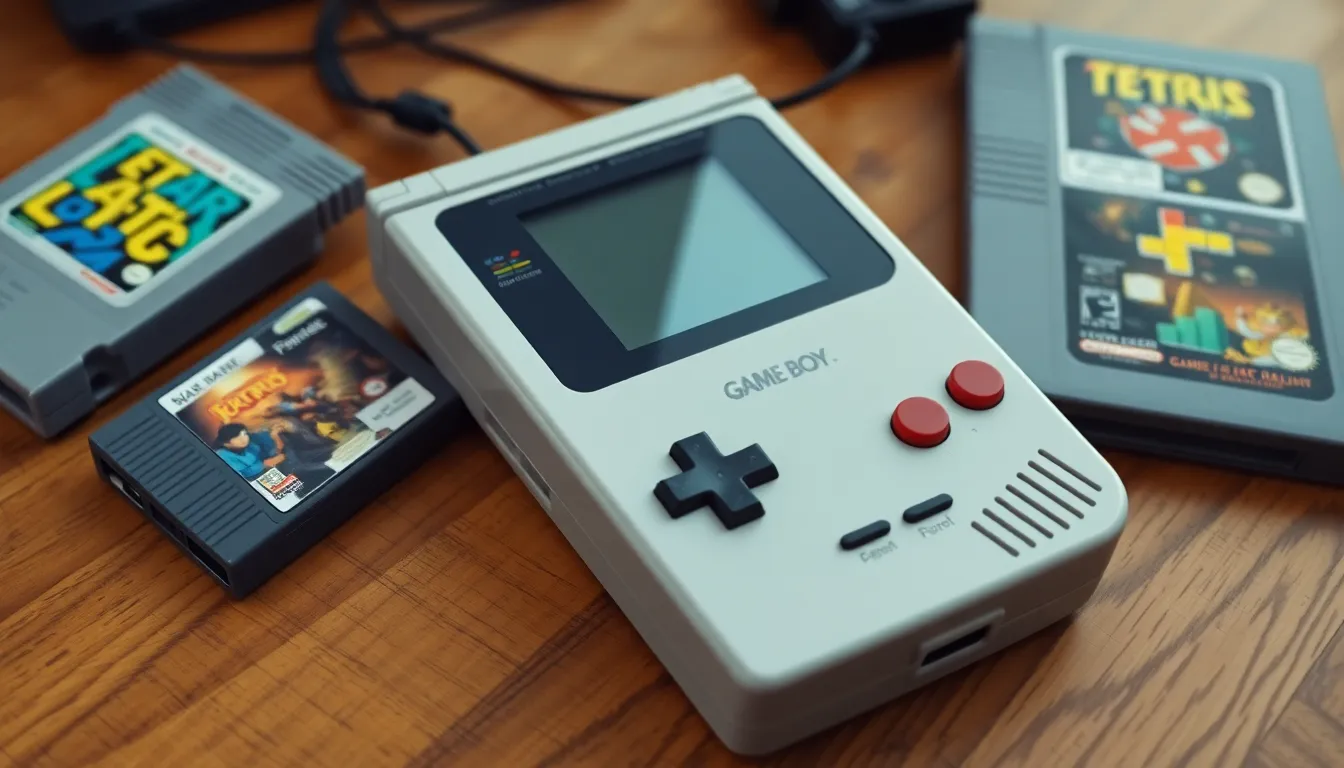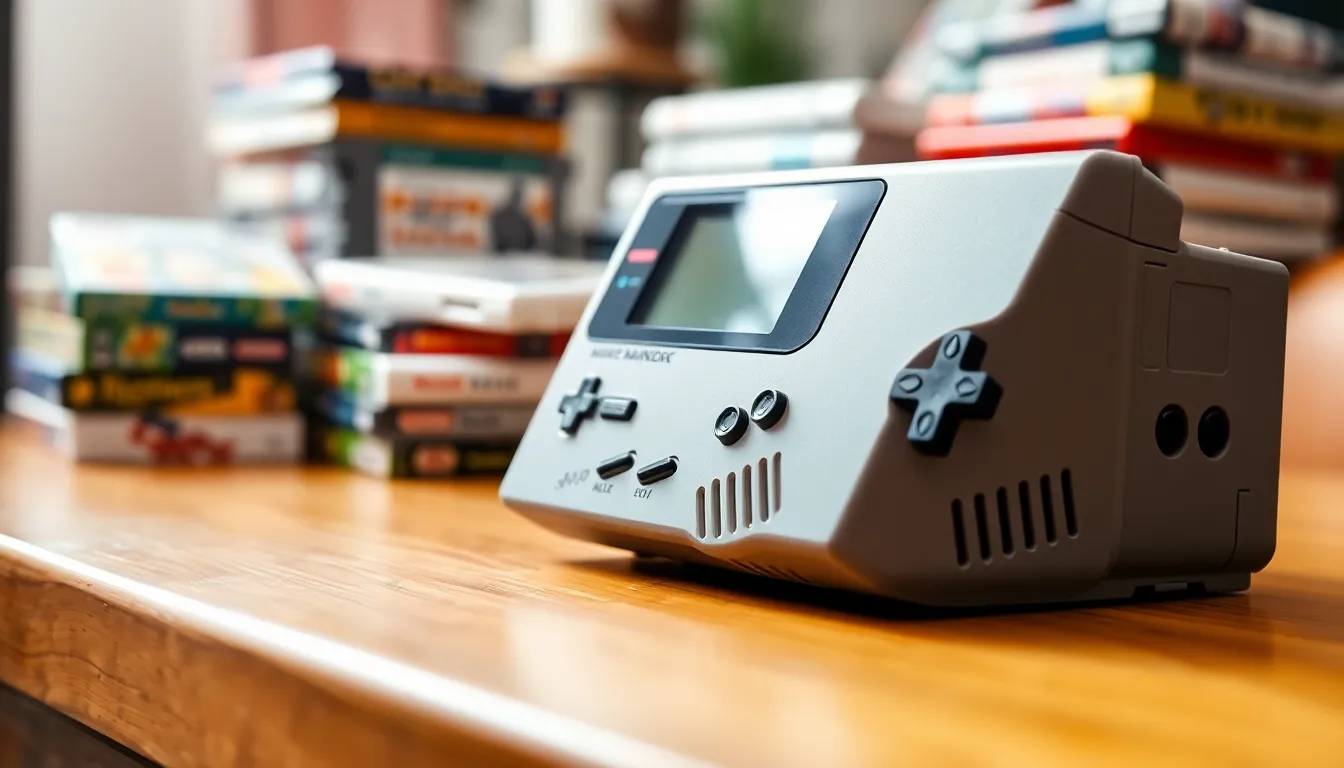In the world of gaming, few devices hold as much nostalgia as the Game Boy. This little gray brick didn’t just change the way people played games; it revolutionized the entire industry. Imagine a time when gaming meant being tethered to a console, and then BAM! A portable device that let players take their adventures on the go. It’s like having a pocket-sized adventure buddy that never complains about battery life—well, almost never.
Table of Contents
ToggleOverview of Game Boy Development
Nintendo initiated the Game Boy development in the 1980s, aiming to create a portable gaming device that combined affordability with functionality. The team focused on using a low-power display to enhance battery life and maintain game quality. In April 1989, the Game Boy debuted, revolutionizing the gaming landscape and setting new standards for handheld consoles.
Engineers at Nintendo designed the device with a simple yet effective interface. The D-pad allowed for intuitive navigation, while the A and B buttons controlled game interactions seamlessly. A built-in speaker provided audio, enhancing the overall gaming experience without compromising portability.
Developers faced multiple challenges during the Game Boy’s creation. Limited hardware performance required optimizations in game design. Developers embraced these constraints, which ultimately led to innovative titles that defined an era, such as Tetris and Super Mario Land.
The Game Boy’s success led to various iterations, including the Game Boy Color and Game Boy Advance. Each version incorporated improved graphics, sound capabilities, and enhanced features while maintaining backward compatibility with original Game Boy titles. This strategic direction kept the Game Boy relevant in a rapidly evolving industry.
From its inception, the Game Boy significantly influenced gaming culture. With millions of units sold worldwide, it established a massive library of games, fostering a vibrant community of players. This legacy continues to inspire handheld gaming, showcasing Nintendo’s ability to adapt and innovate in a competitive market.
Key Milestones in Game Boy Development

The Game Boy’s development journey showcases pivotal moments that shaped handheld gaming. Key phases include initial design concepts, market reception, and subsequent iterations.
Initial Concept and Design
Nintendo aimed to create an affordable portable gaming device in the early 1980s. The company prioritized functionality while considering easy-to-use controls. Designing a low-power display proved essential for extended play. Notably, the inclusion of a D-pad and A/B buttons made navigation intuitive. Iconic Game Boy games like Tetris emerged during the development, showcasing limited hardware capabilities. Ultimately, these design choices laid the foundation for groundbreaking portable gaming experiences.
Launch and Market Reception
Launched in April 1989, the Game Boy quickly gained traction among gamers. Retailers sold over 32,000 units within the first week in Japan, demonstrating strong demand. Gamers appreciated its portability and the appeal of classic titles. Critics praised its simple design and compelling gameplay. By 1990, it dominated the handheld market, outperforming competitors. The success prompted Nintendo to adapt and expand the Game Boy’s library with popular franchises, solidifying its place in gaming history.
Technological Innovations
Innovations in the Game Boy’s design and functionality played a crucial role in its success. The hardware and software advancements helped shape the handheld gaming landscape.
Hardware Specifications
Game Boy features a custom 8-bit Z80 processor that operates at 4.19 MHz. The device includes a LCD display with a resolution of 160 x 144 pixels. This low-power screen ensured long battery life, allowing for up to 30 hours of gameplay on just four AA batteries. Storage consisted of removable game cartridges, initially offering 8 KB of RAM. Enhanced iterations like the Game Boy Color supported 32,768 colors and improved audio capabilities. This evolution in hardware reflected a commitment to optimizing user experience while ensuring portability.
Software Development Tools
Nintendo provided several development tools that empowered game creators. The Game Boy’s development kit included a custom assembler and emulators, facilitating efficient game design. Developers utilized libraries for graphics and sound, which simplified creative processes. Extensive documentation guided programmers in harnessing the full potential of the system. Popular titles such as Tetris utilized these resources effectively, showcasing innovative gameplay and intelligent design. This strong support encouraged a vibrant ecosystem of developers dedicated to delivering unique experiences.
Impact on Gaming Industry
The Game Boy significantly reshaped the gaming industry landscape, laying the groundwork for future handheld devices. Its influence extends well beyond its initial release.
Influence on Future Handheld Consoles
Game Boy’s success set a new standard for portable gaming devices, prompting competitors to innovate. The introduction of the Nintendo DS and PSP followed, each incorporating features inspired by Game Boy’s model. Designers focused on enhancing user experience by prioritizing intuitive controls and engaging gameplay. Battery efficiency became a core design element, with leading devices like the Nintendo Switch reflecting these principles. Many handheld consoles now feature large libraries of compatible games, a trend initiated by the Game Boy’s vast catalog.
Legacy of Game Boy Development
Game Boy’s legacy continues to resonate within the gaming community. Fostering creativity among developers, it inspired many franchises that remain popular today. Titles like Pokémon and The Legend of Zelda emerged, establishing dedicated fanbases. The innovative software development tools provided by Nintendo equipped creators to transcend previous gaming limitations. Even decades later, the principles established during Game Boy’s development influence current handheld gaming, showcasing its enduring impact.
The Game Boy’s journey from concept to iconic status underscores its transformative role in the gaming industry. It not only redefined portable gaming but also set a benchmark for future handheld devices. With its innovative design and a library of engaging titles, it cultivated a passionate community that remains vibrant today.
The lasting influence of the Game Boy is evident in modern gaming consoles that continue to prioritize user-friendly experiences and immersive gameplay. As technology evolves, the principles established by the Game Boy will undoubtedly inspire new generations of developers and gamers alike. This legacy ensures that the spirit of the Game Boy will endure, shaping the future of handheld gaming for years to come.




